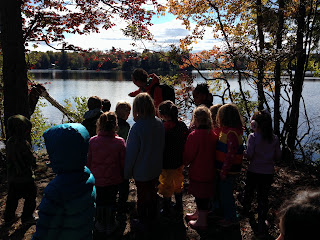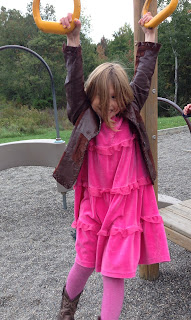 |
| Circling up with friends in the 2-3's before muddy boots. |
Welcome to the new school year! It's been almost two weeks of school for the K-1 children, and we're off to a great start. This is certainly a dynamic, unique, smart, funny, creative, and kind bunch of children.
At the beginning of the year, our focus is on building community. This is essential during these early days. Our time is spent learning to listen respectfully to one another, treat one another kindly, and most importantly, learn skills that will develop and nurture empathy for one another. Having an understanding of how a friend may feel if we say or do something unkind must be the foundation of our learning at this point. We talk a lot about feelings - ours and our friends'. Spending time on these crucial social and emotional skills will pave the way for what's to come.
 |
| Community building with the 2-3's before our muddy boots walk. |
Below is a blog post I shared with families at the beginning of our last school year. I've included it because it is a relevant message during these first weeks of school as children are adjusting. I hope it alleviates any worry or anxiety you may have about your child's transition. These first few weeks will be full of ups and downs - some mornings will run like clockwork, and others will be bumpy. That's all normal as your children internalize the new routines and become adjusted to life as a new Kindergartner or First Grader.
Even though we’ve been back at school for three full weeks, it is not uncommon for some of our little ones to still be adjusting to the demands of a long school day. This adjustment may manifest in the form of anxiety, inflexibility, clinginess, or just pure exhaustion as they try to internalize all that goes along with school. While they may behave perfectly fine and seem chipper at school, it is very common for them to melt down at home, falling apart at the seemingly smallest of disappointments or obstacles.
After all, this is a big change for many of these children. For some, it is their first full day or full week at school. It is our job as adults to acknowledge the strong feelings that come along with a change. Once we have committed to the change, all that is left to do is acknowledge whatever reactions and feelings our child has. Acknowledging that it is hard to be at school for a long day, but that our child is ready for this challenge will go a long way in easing the anxiety. Encourage him or her to express any feelings of sadness, anger, or worry. Hold strong, but don’t try to talk your child out of his/her feelings. If you welcome them, they will pass more quickly.
“When children are overtaxed emotionally, they sometimes misbehave; their intense emotions and the demands of the situation trump their internal resources. The expression of a need or a big feeling therefore results in aggressive, disrespectful, or uncooperative behavior - which is simply proof that children haven’t built certain self-regulation skills yet. Misbehavior is often a cry for help calming down, and a bid for connection.” Daniel J. Siegel, M.D., co-author of the book No Drama Discipline: The Whole Brain Way to Calm the Chaos and Nurture Your Child’s Developing Mind.
Another way uncertainty can manifest is clinginess. Clingy periods tend to coincide with children taking developmental steps toward independence (like starting school). Sometimes they occur when children face new situations or transitions. I advise never resisting clinginess. Yes, there are times we need (or want) to separate, and that’s a healthy and positive thing to do. When we trust that our child needs to be close and give him or her the assurance that we don’t resist this need, separation anxiety eases. So whenever possible — give in wholeheartedly. Hold your child close and try to imagine the day he or she no longer wants to spend time on your lap (or doesn’t fit very well).
Encourage autonomy - a taste of independence doesn’t eliminate separation anxiety and clinginess, but it definitely seems to lessen the frequency, intensity and duration of these episodes. This makes sense, because children who have tasted autonomy have the knowledge that they are capable and will be fine throughout the school day. With more and more opportunity for independence, their confidence will grow and they will begin to venture out of their comfort zone, trying new things, making new friends, and taking risks.
At school these little ones are doing great - they are happy, fully engaged, eager, curious, fun, loving, and cheerful. They are spending their days learning, playing, listening, and talking. Even though this is extremely worthwhile, it is still tiring and a big effort to keep it together all day. It is not surprising that many of these kiddos come home and collapse into a heap of obstinate, stubborn, and headstrong behaviors. Luckily, this will not last forever. In a few short weeks stamina will increase, expectations and routines will be mastered, and these kids will seem like they’ve been doing this forever. Until then, we need to give them our understanding, unconditional love and support, and instill in them the confidence that they have what it takes to master a new year at school. The first step to handling any change is a parent’s conviction. Certain about the change ourselves, we can project that certainty for our child and give him or her the united front of conviction he/she needs to handle this new experience.
And there you have it......this all holds true as we enter our third week of school. I'm also attaching an article that I found to be relevant (and comforting) during this time of transition. It is about staying present with our children - allowing ourselves to acknowledge their challenging behaviors and trusting that they too shall pass.
http://abundantlifechildren.com/2015/09/09/staying-present-with-our-children/






























































